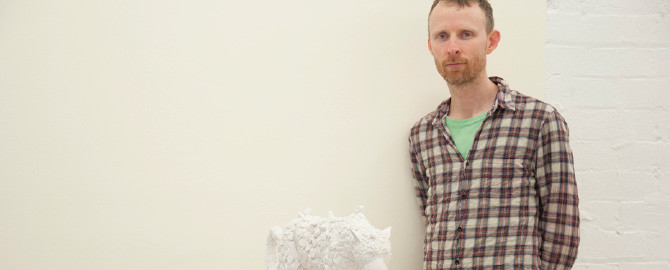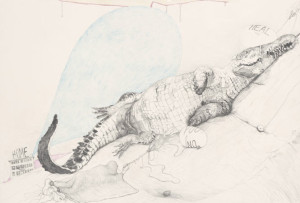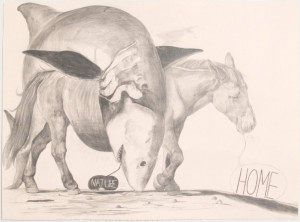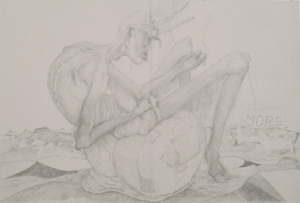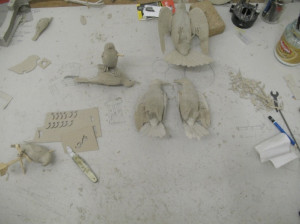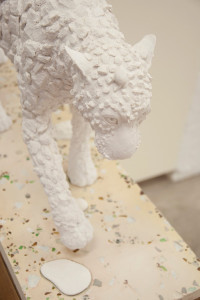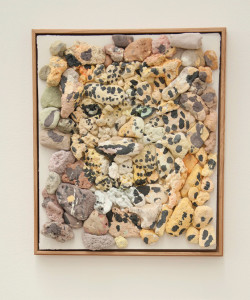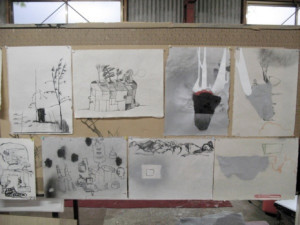Australian artist, Richard Grigg paints, draws, sculpts, his work being inspired by anonymous craftsmen and from many extinct cultures. He combines these sources with daily events, nature journals, history books, comic strips and pulp papers to create contemporary art forms.
With hints of the old masters’ work, his visual imagery and, in particular his drawing, triggers subconscious references to Goya’s Black Paintings. Grigg moves effortlessly from two to three-dimension, and from one discipline to another.
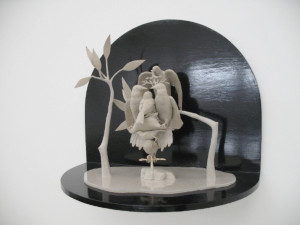
No mores songs at funerals, 2007 – 2009
Laminated boxboard, wooden dowel, glue, pine, Perspex, enameled wood.
440 x 480 x 320mm
In 2007, Grigg completed a three-month residency in Mino, Japan. He has frequently exhibited his works (both in solo and group formats) throughout Australia, and he has also exhibited in Scotland.
In his own words
Could you please introduce yourself and tell us what makes you want to make?
My name is Richard Grigg. I am a visual artist who lives and works in Melbourne, Australia, where I was also born. The want to make and pursue the creation of tangible ideas is an activity, which gradually, from my teens, became a normal thing, a simple passage. Translating momentary ideas into artworks is a process that is ingrained in my identity; I am not quite sure where the original spark comes from, but I do know that I enjoy people looking at my works, getting close to them and connecting to them in a conversation of sorts.
What inspires you and how does it affect your work?
I am not really a guy who understands the need for constant external inspiration, because I feel that work feeds into work and the effort and results demand more effort and more results (until I feel my work is complete). I do, though, have works and things that I read that act as guides and an impetus to continue to make work. The effect readings and objects have on me is that I feel I am a part of a lineage of creativity, and perhaps they also imbue in me a faith in the spirit of creativity and the importance of cultural difference within cultures.
I always instil in my students the importance of drawing, encouraging them to use drawing as the foundation of their work. What disciplines or media do you find integral to the work of an artist and why?
I studied as a drawer and love drawing. You can draw anywhere, any time. The beginning of objectifying ideas used always to start with drawing. I was fairly obsessive about it, waking up and falling asleep with a pencil, drawing anything that interested me. I copied a lot of old master drawings and sculptures and was drawn towards practices that had a strong draughtsperson’s approach. I loved Goya, Del Sarto, Tintoretto, Van Gogh, Da Vinci and Rembrandt, and was definitely interested in the old concept of entering a guild of artists. My approach when I was first learning was to ignore anything except for what happened on the page. I have since learned that art is as much about personal cultivation as it is about turning a line inside and being able to read and translate drawings like a language. For my mind, it is important to understand what it is you are trying to express, such that it is not just about drawing for its own sake. Certainly the skill to render and compose on a page is fundamental, but also important is the skill of diverse research and being able to engage with complex ideas.
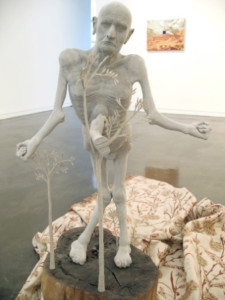
This is my son he is an artist, 2009
Laminated boxboard, wooden stump, wooden dowel, glue, found rug.
Dimensions various
Your work is conceptual, challenging the viewer. Describe the steps involved in creating your works. How do you develop your ideas, through to resolved finished images?
The work that I make for the most part is composed from several ideas. I’m not really a conceptual artist; rather, I stand in a line of traditional, craft-based artists. Certainly, I am very interested in having a concept to fire from but, compared to other Australian artists like Alex Martinis Roe, you wouldn’t call me a conceptual artist. Recently I have returned to study and have been reading more and more, following mental threads to some great discoveries. My interest in continental philosophy has increased, as well as that of art theorists and also of neurology. I am more convinced now that art springs from ideas that demand the use of relevant materials, so each idea has its own needs.
I have been learning to create various moulds and also how to handle different casting mediums. My process is necessary because I am currently interested in several things: the Taoist principal of negative space which relates to functionality; the symbol of the ruin as a spacing in-between two states, and also the effect of repetition on the brain. Bearing these things in mind I have created a collection of works that act as symbols – vessels, wood that appears malleable, portraits that are cast out of broken things and apples.
How has your work grown and progressed over the past 5 years?
For the past few years I have been affected by a disorder of the brain that doesn’t allow me to draw and write in a normal manner. As I have said, previously I was all about the solid and demanding discipline of drawing but, with that gone (and I mourn that), I have to address and make works that are about functionality and physicality. I have progressed my notion of my own body and have a far greater understanding of the mechanism of the brain. My previous work still addressed similar concepts regarding the density of signs contained in the moment, but the processes were far more physically demanding. I loved crafting birds in various guises and drawing peculiar, detailed things, but now I am interested more in texture and the need to be affected by the surface of broken things.
What do you feel are the most challenging aspects of sculpture and why?
Probably the most challenging thing is devising methods to make the structure sound and safe without these devices being seen. The most challenging thing is to not have it fall apart or topple over. This sounds like a thing removed from aesthetics, but it is really important to know through trial and error the personality of each sculpture and how best to present them. This also really helps with documentation by knowing which angle best demonstrates the character of your sculpture.
Sculpture in my practice (maybe more previous than now) was just a natural extension from drawing. I would spend a long time redrawing aspects until I knew and saw that shape in my mind. Now the sculptures and their attributes happen as the work happens, and although I still sketch in a crude manner before and during, the process is a lot more mental with less paper.
What concepts are you currently exploring and what will you embark on next?
I have just made a series of works based on the form of the leopard, which initially sprung from a dream I had about the animal. I have several more of these that I wish to make in different dimensions and to experiment with contrasting materials that I wish to cast. I want to experiment more with wax and also to continue making more terrazzo works, which in turn feeds my interest in glass and rock combinations that could mimic certain forms. Further to these I have some larger scale vessels that I am making that will investigate even more closely disjointed functionality, because presently everything I make is based entirely on the feelings towards, and the facts of, my functionality.
Australian contemporary artist, Richard Grigg graduated from Melbourne’s Victorian College of the Arts (Drawing) in 1995. He currently lives in Melbourne and he is represented by Block Projects.
All images courtesy of Richard Grigg | www.richardgrigg.com
For more information on Hong Kong Art Tutoring please contact:
Gail Deayton
Telephone: +852 9722 8353
Email: gail@hkarttutoring.com

